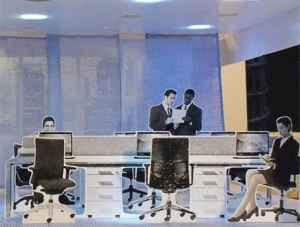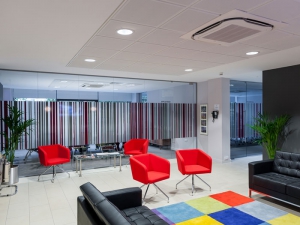‘The office is not merely a passive backdrop for work’
Words by Jeremy Myerson
 Compared with environments such as libraries, theatres and the urban realm, too much workplace design is fundamentally out of balance, prioritising either experience or practicality at the expense of our emotional needs
Compared with environments such as libraries, theatres and the urban realm, too much workplace design is fundamentally out of balance, prioritising either experience or practicality at the expense of our emotional needs
It is one of the ironies of the early 21st century that working life is often so devoid of life. Why is this the case, when there is so much current investment in workplace design
However, there is an undeniable weight of evidence out there that suggests that things aren’t working as well as they should be; successive research studies around the world point to falling occupancy rates in office buildings and growing levels of dissatisfaction, disassociation, stress and sick leave among office workers.
How to cultivate alternative approaches capable of making the workplace a better environment for people – more dynamic, more engaging, more flexible and more inclusive – has become a Holy Grail for researchers. Not just for the usual office obsessives either. Faced with work environments that can be so flat, so uninspiring, so dead in spirit, managers of all stripes are looking for new people-centred ideas.
When I sat down to co-write a new book, Life of Work, with architectural designer Imogen Privett, we discovered something important staring us right in the face. The more we investigated alternative ideas drawn from such settings as academic libraries, theatre productions, air traffic control or temporary urban events, the more we became convinced that too much workplace design is fundamentally out of balance.
We came to a key way of thinking about the workplace as a combination of process and experience, what we do and how we feel. Much workplace design tends to focus on one at the expense of the other. Some offices, for example, support working processes and practices efficiently but fail to create a positive, welcoming experience; others generate a great ambience or look visually arresting but are incoherent in terms of enabling work process.
We’ve all been in “lean” workplaces that are efficient but completely soulless – they are all about process. Equally, who can forget those workplaces with a fun, funky ambience (all swings and artificial turf) in which the noise and distractions make it virtually impossible to get any real work done – they are all about experience.
However these two aspects, what we do and how we feel, need to mirror each other if we are to create a more effective, supportive and productive workplace. Most workplaces tend to veer towards process. Extensive studies of ergonomics and environmental conditions have given us a pretty good understanding of the basic physical requirements that are most conducive to work. Many of these are enforced by rigorous design standards.
Although the primary function of the workplace is to provide a functional space that supports people in performing their jobs, it is not merely a passive backdrop for work. We spend a significant portion of our lives at work, and the level of interaction between people and the office environment demands more than just an adherence to health and safety, time and motion. There is an emotional and psychological dimension too.
The recognition that work is a combination of process and experience, each with needs that must be met, requires new models for designing our workplaces and evaluating how they perform. Are we up to the challenge? Of course we are. We just need to think about a new type of balance between process and experience.
Only thinking about the effects of the design of the environment when it actively de-motivates people is not a helpful state of affairs, but it is often the current one. That needs to change.
Jeremy Myerson is the co-author with Imogen Privett of Life of Work: What Office Design Can Learn from the World Around Us (Black Dog Publishing). He co-founded the Helen Hamlyn Centre for Design at the Royal College of Art in 1999, where he was also professor of design from 2008-2015, and is currently setting up the WORKTECH Academy at Unwired
